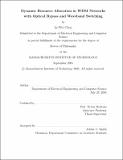Dynamic resource allocation in WDM networks with optical bypass and waveband switching
Author(s)
Chen, Li-Wei, Ph. D. Massachusetts Institute of Technology
DownloadFull printable version (1.919Mb)
Alternative title
Dynamic resource allocation in wavelength division multiplexing networks with optical bypass and waveband switching
Other Contributors
Massachusetts Institute of Technology. Dept. of Electrical Engineering and Computer Science.
Advisor
Eytan Modiano.
Terms of use
Metadata
Show full item recordAbstract
In this thesis, we investigate network architecture from the twin perspectives of link resource allocation and node complexity in WDM optical networks Chapter 2 considers networks where the nodes have full wavelength accessibility, and investigates link resource allocation in ring networks in the form of the routing and wavelength assignment problem. In a ring network with N nodes and P calls allowed per node, we show that a necessary and sufficient lower bound on the number of wavelengths required for rearrangeably non-blocking traffic is PN/41 wavelengths. Two novel algorithms are presented: one that achieves this lower bound using at most two converters per wavelength, and a second requiring 2PN/71 wavelengths that requires significantly fewer wavelength converters. Chapter 3 begins our investigation of the role of reduced-complexity nodes in WDM networks by considering networks with optical bypass. The ring, torus, and tree architectures are considered. For the ring, an optical bypass architecture is constructed that requires the minimum number of locally-accessible wavelengths, with the remaining wavelengths bypassing all but a small number of hub nodes. The routing and wavelength assignment for all non-hub nodes is statically assigned, and these nodes do not require dynamic switching capability. (cont.) Routing and wavelength assignment algorithms are then developed for the torus and tree architectures, and this bypass approach is extended to these topologies also. Chapter 4 continues by considering waveband routing as a second method of reducing node complexity. We consider a two-dimensional performance space using number of wavelengths and wavebands as metrics in evaluating waveband switching networks. We derive bounds for the achievable performance region based on the minimum required number of wavelengths and wavebands. We then show by construction of several algorithms that a wavelength-waveband tradeoff frontier can be achieved that compares very favorably to the bounds. Finally, Chapter 5 concludes by considering hybrid networks with both static and a dynamic wavelength provisioning. We use an asymptotic analysis where we allow the number of users in the network to become large, and via a geometric argument derive the optimal static and dynamic provisioning (in both wavelength-switched and waveband-switched scenarios) as a function of the traffic statistics to achieve non-blocking performance. (cont.) We then extend our results to networks with a finite (possibly small) number of users where a target overflow probability is allowed. We show that by using hybrid provisioning in conjunction with waveband switching, using just a small number of switches we can obtain performance very close to a fully dynamic wavelength-switched network. %
Description
Thesis (Ph. D.)--Massachusetts Institute of Technology, Dept. of Electrical Engineering and Computer Science, 2005. This electronic version was submitted by the student author. The certified thesis is available in the Institute Archives and Special Collections. Includes bibliographical references (p. 171-175).
Date issued
2005Department
Massachusetts Institute of Technology. Department of Electrical Engineering and Computer SciencePublisher
Massachusetts Institute of Technology
Keywords
Electrical Engineering and Computer Science.